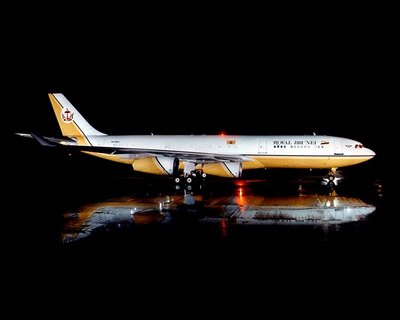
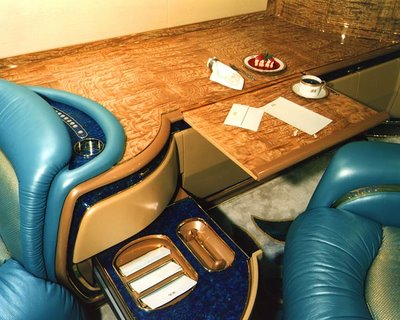


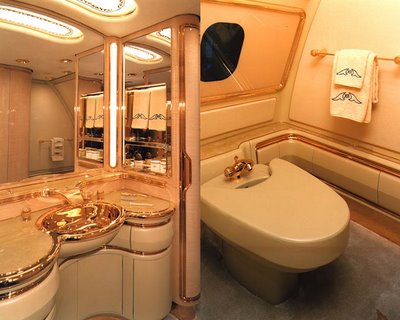
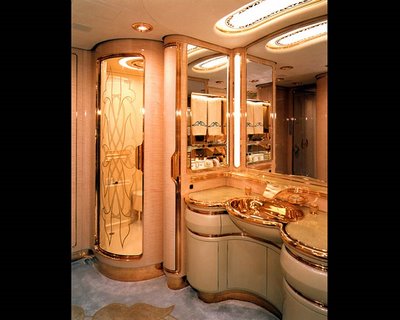
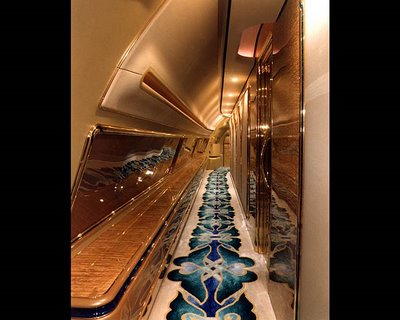
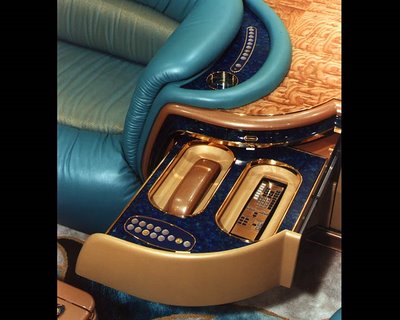

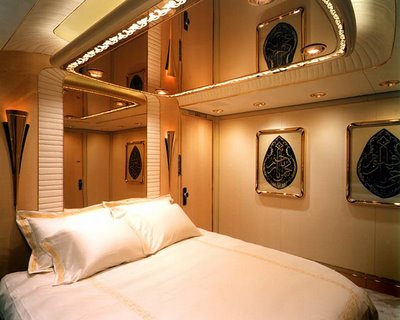
This Airbus 340 aircraft was "remodeled" in Waco . Yes, the sinks are solid gold and one of them is Lalique crystal. The Sultan bought the aircraft for roughly $100M; had it flown to Waco , brand-new, had the interior completely removed; and had the folks at E-Systems (now Raytheon) install $120M worth of improvements inside and outside.
Wednesday, April 11, 2007
Sultan of Brunei's Private Airplane
Tuesday, April 10, 2007
50 THINGS EVERYONE SHOULD KNOW
(or 50 Completely Useless Facts!) | ||
|
| ||
| The word "queue" is the only word in the English language that is still pronounced the same way when the last four letters are removed. Beetles taste like apples, wasps like pine nuts, and worms like fried bacon. Of all the words in the English language, the word 'set' has the most definitions! What is called a "French kiss" in the English speaking world is known as an "English kiss" in France. "Almost" is the longest word in the English language with all the letters in alphabetical order. "Rhythm" is the longest English word without a vowel. Horatio Nelson, one of England's most illustrious admirals was throughout his life, never able to find a cure for his sea-sickness. The skeleton of Jeremy Bentham is present at all important meetings of the University of London Right handed people live, on average, nine years longer than left-handed people Adolf Hitler was a vegetarian, and had only ONE testicle. Months that begin on a Sunday will always have a "Friday the 13th." Coca-Cola would be green if colouring weren’t added to it. The average lead pencil will draw a line 35 miles long or write approximately 50,000 English words. More people are allergic to cow's milk than any other food. The six official languages of the United Nations are: English, French, Arabic, Chinese, Russian and Spanish. Earth is the only planet not named after a god. Some worms will eat themselves if they can't find any food! The worlds oldest piece of chewing gum is 9000 years old! The longest recorded flight of a chicken is 13 seconds Queen Elizabeth I regarded herself as a paragon of cleanliness. She declared that she bathed once every three months, whether she needed it or not Slugs have 4 noses. A man named Charles Osborne had the hiccups for 69 years! The average person laughs 10 times a day! An ostrich's eye is bigger than its brain | ||
Most Expensive Homes In The World: Top Five

No. 1
$139 million (£75 million)
Updown Court
Windlesham, England
Thanks to shifting exchange rates, Updown Court is still, it appears, the most expensive home in the world. And no wonder: The unlived-in mansion encompasses 103 rooms, five swimming pools and its own 50-seat screening room. The property oozes opulence, from the 24-carat-gold leafing on the library floor to the heated marble driveway. With your own squash court, bowling alley and tennis court, you may never need to leave--except to visit the queen at nearby Windsor Castle. It is listed with Hamptons International and Savills.

No. 2
$135 million
Starwood Estate
Aspen, Colo.
It's a record-setting prince--er, price. Prince Bandar bin Sultan bin Abdul Aziz, former Saudi Arabian ambassador to the U.S., has put his 95-care ranch on the market. The Starwood Ranch estate includes a 56,000-square-foot mansion with 15 bedrooms and 16 baths, several smaller buildings, stables, a tennis court and an indoor swimming pool. Listed with Joshua Saslove at Joshua & Co.

No. 3
$125 million
Maison de L'Amitie
Palm Beach, Fla.
In 2004, Donald J. Trump bought former health care executive Abe Gosman's palace, Maison de L'Amitie, at a bankruptcy auction for $41.25 million. With the refurbished version--complete with ballroom, conservatory, 100-foot-long swimming pool and 475 feet of oceanfront--he aims to set a U.S. sales record. It is listed with Dolly Lenz and Geoff Thomas at Prudential Douglas Elliman.

No. 4
$100 million
Waterfront Estate
Istanbul, Turkey
The fourth most expensive home in the world is in a somewhat unexpected spot. Located on three-quarters of an acre directly on the Bosphorus, this residence offers more than 30,000 square feet of opulent living space in 64 rooms. Details include gilded moldings and crystal chandeliers. The mansion has a rare quay that is nearly 200 feet long. Listed with Alp Sahin at Luici Real Estate Agency.

No. 5
$92 million (£50 million)
Toprak Mansion
London, England
When a Turkish entrepreneur builds a neoclassical palace in modern London, the result is Halis Toprak's over-the-top home. The main living space (not including staff and guest apartments) totals about 28,000 square feet, and includes twin grand staircases, four kitchens and an 80-foot-long grand salon. There is an indoor leisure complex with swimming pool, Turkish bath and sauna, and two acres of landscaped grounds. The property is being offered through Trevor Abrahmsohn at Glentree Estates.
Monday, April 9, 2007
Amazing Air Magic!!
These are some photos of St. Maarten Airport and the planes impress most people on the beach flying over just seconds before touching down at Princess Juliana Airport. This is a just a little too close for comfort.

12 Boeing 747s operate daily to St. Maarten. The heavy jumbo is the most impressive of all and attracts the looks of everybody around...

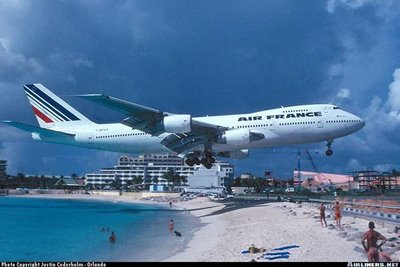


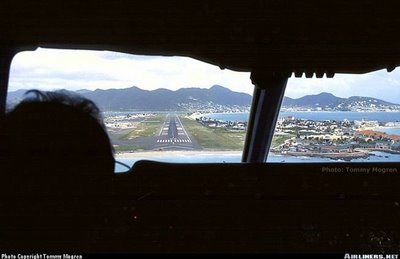
This photo, from inside one 747 of Air France , it possible to have one idea of the small strip of beachjust before the head of the landing strip for planes in St. Maarten.




Public Toilet in Switzerland Amazing right?
Public Toilet in Switzerland Amazing right?
Here's a picture of a public toilet in Switzerland.

Now that you have seen the outside view of the Toilet,Just spend some more time scrolling down to see how it looks from inside ..!!
...
...
...
...
...
...
...
...
...

That's made entirely out of one-way glass. No one can see you in there, but when you are inside, it looks like you're sitting in a clear glass box.
Next Gates, not an American, but an Indian
The next Bill Gates is born and he could be an Indian. This million dollar question is ticking all minds with Indians emerging as strong contenders in the race among the Asians.
A report released by two Washington-based organisations -- Zogby International and 463 Communications showed that nearly half of all Americans (49%) believe that the next great technology leader will come from either China (26.7%) or Japan (22.4%).
Twenty-one per cent say that "next Bill Gates" will come from the United States while 13 per cent believe he or she will come from India. Russia (2.1%) and Brazil (0.4%) were cited as other possibilities.
"The next Bill Gates has already been born, and time will tell what country is providing the environment of innovation, entrepreneurism and opportunity to enable him or her to flourish with the next great idea," said 463 partner Tom Galvin.
With an "Internet everywhere" mindset, most Americans believe that soon there will be no place in the world where we won't be able to access the Net, as new technologies are fast turning the world into a place of voyeurs and paparazzis.
While the Web is roughly 550 years younger than the printing press, one-third (32 per cent) of all Americans believe that the Internet is a greater invention. An overwhelming majority believes that a typical 12-year-old knows more about the Internet than their member of Congress.
What you all guys comment about "THE NEXT"?
No Special Effects Here? This is REAL
How Tech Companies Got Their Names
Here’s some fun facts: A list of how companies got their names. The list isn’t exclusively tech companies, but some of the more interesting stories are from web-tech leaders.
Keep in mind that this is from Wikipedia, so I wouldn't want bet the farm on the veracity of them all, but it's still some good trivia for the boring work party this evening.
Apple - for the favourite fruit of co-founder Steve Jobs and/or for the time he worked at an apple orchard. Apple wanted to distance itself from the cold, unapproachable, complicated imagery created by other computer companies at the time.
eBay - Pierre Omidyar, who had created the Auction Web trading website, had formed a web consulting concern called Echo Bay Technology Group. “Echo Bay” didn’t refer to the town in Nevada, “It just sounded cool,” Omidyar reportedly said. Echo Bay Mines Limited, a gold mining company, had already taken EchoBay.com, so Omidyar registered what (at the time) he thought was the second best name: eBay.com.
Google - a deliberate misspelling of the word googol, reflecting the company’s mission to organize the immense amount of information available online.
Hotmail - Founder Jack Smith got the idea of accessing e-mail via the web from a computer anywhere in the world. When Sabeer Bhatia came up with the business plan for the mail service he tried all kinds of names ending in ‘mail’ and finally settled for Hotmail as it included the letters “HTML” — the markup language used to write web pages. It was initially referred to as HoTMaiL with selective upper casing.
Yahoo - a backronym for ‘Y’et Another Hierarchical Officious Oracle. The word Yahoo was invented by Jonathan Swift and used in his book Gulliver’s Travels. It represents a person who is repulsive in appearance and barely human. Yahoo! founders David Filo and Jerry Yang jokingly considered themselves yahoos
And my personal favorite and most fitting: Lycos - from Lycosidae, the family of wolf spiders.
For more click this link A list of how companies got their names
Some Interesting Facts
Here are some interesting, but true facts, that you may or may not have known.
1. The Statue of Liberty's index finger is eight feet long
2. Rain has never been recorded in some parts of the Atacama Desert in Chile
3. A 75 year old person will have slept about 23 years.
4. A Boeing 747's wing span is longer than the Wright brother's first flight.(the Wright brother's invented the airplane)
5. There are as many chickens on earth as there are humans.
6. One type of hummingbird weighs less than a penny
7. The word "set " has the most number of definitions in the English language - 192
8. Slugs have four noses
9. Sharks can live up to 100 years
10. Mosquitos are more attracted to the color blue than any other color.
11. Kangaroos can't walk backwards
12. About 75 acres of pizza are eaten in in the U.S. everyday
13. The largest recorded snowflake was 15in wide and 8in thick. It fell in Montana in 1887
14. The tip of a bullwhip moves so fast that the sound it makes is actually a tiny sonic boom.
15. Former president Bill Clinton only sent 2 emails in his entire 8 year presidency
16. Koalas and humans are the only animals that have finger prints
17. There are 200,000,000 insects for every one human
18. It takes more calories to eat a piece of celery than the celery had in it to begin with.
19. The world's largest Montessori school is in India, with 26,312 students in 2002
20. Octopus have three hearts
21. If you ate too many carrots, you'd turn orange
22. The average person spends two weeks waiting for a traffic light to change.
23. 1 in 2,000,000,000 people will live to be 116 or old
24. The body has 2-3 million sweat glands
25. Sperm whales have the biggest brains; 20 lbs
26. Tiger shark embroyos fight each other in their mother's womb. The survivor is born.
27. Most cats are left pawed
28. 250 people have fallen off the Leaning Tower of Pisa
29. A Blue whale's tongue weighs more than an elephant
30. You use 14 muscles to smile and 43 to frown. Keep Smiling!
31. Bamboo can grow up to 3 ft in 24 hours
32. An eyeball weighs about 1 ounce
33. Bone is five times stronger than steel.
Friday, April 6, 2007
NASA Spent Millions to Develop a Pen that Would Write in Space, whereas the Soviet Cosmonauts Used a Pencil

The AG-7 original space pen, pictured above, used pressure instead of gravity to make a specially formulated ink flow.
During the height of the space race in the 1960s, legend has it, NASA scientists realized that pens could not function in space. They needed to figure out another way for the astronauts to write things down. So they spent years and millions of taxpayer dollars to develop a pen that could put ink to paper without gravity. But their crafty Soviet counterparts, so the story goes, simply handed their cosmonauts pencils.
This tale with its message of simplicity and thrift--not to mention a failure of common sense in a bureaucracy--floats around the Internet, hopping from in-box to in-box, and even surfaced during a 2002 episode of the West Wing. But, alas, it is just a myth.
Originally, NASA astronauts, like the Soviet cosmonauts, used pencils, according to NASA historians. In fact, NASA ordered 34 mechanical pencils from Houston's Tycam Engineering Manufacturing, Inc., in 1965. They paid $4,382.50 or $128.89 per pencil. When these prices became public, there was an outcry and NASA scrambled to find something cheaper for the astronauts to use.
Pencils may not have been the best choice anyway. The tips flaked and broke off, drifting in microgravity where they could potentially harm an astronaut or equipment. And pencils are flammable--a quality NASA wanted to avoid in onboard objects after the Apollo 1 fire.
Paul C. Fisher and his company, the Fisher Pen Company, reportedly invested $1 million to create what is now commonly known as the space pen. None of this investment money came from NASA's coffers--the agency only became involved after the pen was dreamed into existence. In 1965 Fisher patented a pen that could write upside-down, in frigid or roasting conditions (down to minus 50 degrees Fahrenheit or up to 400 degrees F), and even underwater or in other liquids. If too hot, though, the ink turned green instead of its normal blue.
That same year, Fisher offered the AG-7 "Anti-Gravity" Space Pen to NASA. Because of the earlier mechanical pencil fiasco, NASA was hesitant. But, after testing the space pen intensively, the agency decided to use it on spaceflights beginning in 1967.
Unlike most ballpoint pens, Fisher's pen does not rely on gravity to get the ink flowing. The cartridge is instead pressurized with nitrogen at 35 pounds per square inch. This pressure pushes the ink toward the tungsten carbide ball at the pen's tip.
The ink, too, differs from that of other pens. Fisher used ink that stays a gellike solid until the movement of the ballpoint turns it into a fluid. The pressurized nitrogen also prevents air from mixing with the ink so it cannot evaporate or oxidize.
According to an Associated Press report from February 1968, NASA ordered 400 of Fisher's antigravity ballpoint pens for the Apollo program. A year later, the Soviet Union ordered 100 pens and 1,000 ink cartridges to use on their Soyuz space missions, said the United Press International. The AP later noted that both NASA and the Soviet space agency received the same 40 percent discount for buying their pens in bulk. They both paid $2.39 per pen instead of $3.98.
The space pen's mark on the Apollo program was not limited to facilitating writing in microgravity. According to the Fisher Space Pen Company, the Apollo 11 astronauts also used the pen to fix a broken arming switch, enabling their return to Earth.
Since the late 1960s American astronauts and Russian cosmonauts have used Fisher's pens. In fact, Fisher has created a whole line of space pens. A newer pen, called the Shuttle Pen, was used on NASA's space shuttles and on the Russian space station, Mir. Of course, you don't have to go to space to get your hands on a space pen--earthbound folks can own one for the low, low price of $50.00.
Google’s Chief Gets $1 in Pay; His Security Costs $532,755
The Internet search giant paid its top executive, Eric E. Schmidt, a salary of $1 and a holiday bonus of $1,723 in 2006, according to a regulatory filing Wednesday. But Mr. Schmidt’s personal security cost shareholders $532,755, representing the bulk of his compensation. Mr. Schmidt also received $22,456 to offset taxes due on a perk: the use of a Google-chartered aircraft by family members and friends.
Google’s co-founders, Sergey Brin, president of technology, and Larry Page, president of products, earned the same salary and bonus as Mr. Schmidt. Mr. Page received an additional $36,795 for transportation, logistics and personal security.
The token salaries represent a sacrifice that Google’s top executives can afford to make. As of March 1, according to the filing, Mr. Schmidt owned more than 10.7 million shares, worth more than $5 billion at Wednesday’s closing price of $471.02. Mr. Brin owned 28.6 million shares worth about $13.5 billion, and Mr. Page owned nearly 29.2 million shares worth about $13.7 billion. Each sold shares worth hundreds of millions of dollars in the 12 months since the previous proxy filing.
The salary and bonuses paid to Mr. Schmidt, Mr. Brin and Mr. Page reflect little change from 2005, when they each earned a salary of $1 and bonuses of $1,630 to $1,723.
For the latest filings, guidance by the Securities and Exchange Commission included personal security as a perk that should be listed as compensation, said Jon Murchinson, a Google spokesman. He would not give further details about Mr. Schmidt’s security expenses.
Four other Google executives — the chief financial officer, George Reyes; the senior vice president for business operations, Shona Brown; the chief legal officer, David Drummond; and the senior vice president for product management, Jonathan Rosenberg — earned salaries of $250,000 each.
Adding other compensation, including stock option awards and incentives, they earned $1.7 million to $2.8 million. They also held unvested stock options with an estimated worth as of Dec. 31, 2006, that ranged from $21 million for Ms. Brown to $30 million for Mr. Drummond.
The company’s filing also includes a shareholder proposal to be voted on at the company’s May 10 annual meeting that would require Google to resist demands for censorship by all legal means and would prevent it from holding data that could be used to identify individuals in countries that restrict freedom of speech.
In recent years, Google has been criticized for its decision to create a search engine for the Chinese market that censors certain results. And its rival Yahoo has come under fire from human rights groups for handing over personal information to the Chinese authorities about users who were later imprisoned for criticizing the government.
Google’s board recommended that shareholders vote against the proposal.
Tuesday, April 3, 2007
French Train Breaks Rail Speed Record
Aboard the fastest TGV in the world
A supercharged TGV train with two locomotives and extra-large wheels has set a new world rail speed record, hitting 574.8kmh on a high-speed track in eastern France. 
 A French high-speed train broke the world speed record on rail today, reaching 357 miles (574.8 kilometers) an hour in a much publicized test in eastern France, exceeding expectations to travel at 150 meters per second, or 540 kilometers an hour.
A French high-speed train broke the world speed record on rail today, reaching 357 miles (574.8 kilometers) an hour in a much publicized test in eastern France, exceeding expectations to travel at 150 meters per second, or 540 kilometers an hour. The train, code-named V150, is a research prototype meant to demonstrate the superiority both of the TGV high speed train and of its likely successor, the AGV, which is also manufactured by the French engineering group Alstom. The performance on Tuesday came close to but did not break the world speed record for any train, set by an electromagnetic train in 2003.
The French railroad company SNCF and Alstom publicized the event as a test of “French excellence,” building on national pride for the 25-year-old bullet train.
The train reached its maximum speed in about 16 minutes at a site about 125 miles from Paris on a specially chosen sector of rail tracks of the new Eastern Europe TGV line, which will begin to serve Paris to Strasbourg in June. The V150 train, with a reduced number of train cars and larger wheels, incorporates technological elements from the AGV.
SNCF and Alstom insist the demonstration does not fulfill any immediate commercial purposes, but others say the speed could serve as a selling point in Asia and other markets.
“This world speed record is intended for research, to improve security and performance. And today the train that runs the fastest is the Eastern TGV,” said Anne-Marie Idrac, the head of SNCF upon leaving the train. “We don’t see the market today for such high speed.”
Alstom, the world high-speed train leader with 21 percent of the market, is hoping it might parlay the record into sales, as its competitors — Siemens of Germany and Hitachi of Japan — have cut into Alstom’s lead in the competition for the market.
High-speed trains are a potentially lucrative market in developing countries — China and India are the biggest markets, with China spending about 15 billion euros a year on its rail sector, while India is looking at developing a high-speed train network.
Crowds had gathered on bridges overlooking the rail tracks to watch the train race by, and national television broadcast live images from the train.
The Maglev from Japan holds the world record for a train with a speed of 581 kilometers (361 miles) an hour recorded in 2003; it uses electromagnetic technology, where the train does not actually touch the rail. This technology is more costly, typically runs shorter distances and is less compatible with existing rail networks.
High-speed trains have not caught on in the United States as they have in Europe, where TGV is generally considered to provide faster transportation than air travel for train trips of less than 3 hours.
France operates 400 TGV trains on about 1,100 miles of track built especially for high speeds.
The black and chrome train with three double-decker cars bettered the previous record set in 1990.
Boeing’s Anti-Hijack Autopilot

Negative terrorism hype aside, flying is still a very safe mode of transport. The only real danger is being beaten to dearth by a group of radical environmentalists for polluting the atmosphere.
Boeing, though, is taking no chances and thinks its latest autopilot is the perfect answer to anti-terrorism. Classed as a 9/11-proof system, it will stop terrorists from flying the plane into land or sea targets and can be remotely landed by ground-staff. Once activated, it cannot be deactivated.
The captain can activate the system manually or - and this is the bit I have some concern with - it can activate itself when sensors fitted to the cockpit door record excessive force – like terrorists trying to break in.
Hmm, what happens if turbulence causes someone to fall against the door, a drunk passenger needs to tell the captain something really, really important, or a rogue drinks trolley hits it? Boeing could have these in all planes with three years, according to insiders.
World’s Costliest Phone: Going, going…GONE!

There are probably better ways to spend £680,000 but for one geezer owning the world’s most expensive mobile phone came out tops.
The “Piece Unique” is one of three created by Swiss company, Goldvish. Covered in gold and encrusted with an obscene number of flawless diamonds, the phone was presented to the Russian tycoon at the Millionaire's Fair at Cannes last Saturday. The Guinness Book of World Records was even on hand to confirm it as the world’s most expensive phone.
Of the remaining two, one has been sold to a Hong Kong businessman which leaves the other still up for grabs.
Break that piggy bank now.Monday, April 2, 2007
World Cup 2007 Opening Ceremony!!
Cricket Fever ~ World Cup 2007 Opening Ceremony !!

Performers dance as fireworks illuminate the night sky in presence of the all 16 countries cricketers during the opening ceremony of the ICC World Cup Cricket 2007 in Trelawny, 11 March 2007
Fireworks burst over Trelawny Stadium during the opening ceremony for the Cricket World Cup.
India's cricket team enter the stadium during the opening ceremony of the Cricket World Cup in Trelawny, Jamaica
England's cricket captain Michael Vaughan, left, and teammate Andrew Flintoff watch the opening ceremony of the ICC Cricket World Cup
All 16 countries cricketers watch as illuminations light the night sky during the opening ceremony of the ICC World Cup Cricket 2007 in Trelawny, 11 March 2007.
West Indies cricket legend Sir Garfield Sobers speaks during the opening ceremony of the ICC Cricket World Cup at Trelawny Stadium, Jamaica
Members of the New Zealand cricket team arrive in stadium to participate in the opening ceremony of the Cricket World Cup in Trelawny, Jamaica


Dancers perform during the Opening Ceremony of the Cricket World Cup in Trelawny, Jamaica













